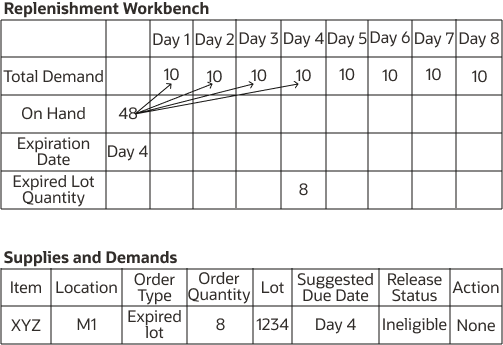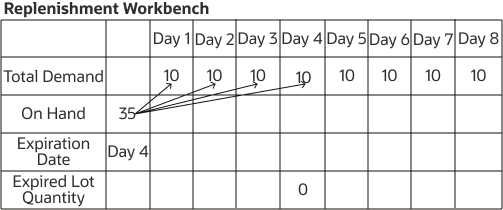How On-Hand Lots Are Consumed in Replenishment Plans
On-hand lots are consumed in replenishment plans in the order of their expiration dates.
This is the process for consumption of on-hand lots in replenishment plans:
- The on-hand lots are arranged in the order of their expiration dates.
- The first on-hand lot is consumed with the total demand within the lot expiry date.
- If the on-hand lot isn't completely consumed on or before the expiration date, the
unused quantity is calculated as expired and reduced from the projected available
balance. The expired lot quantity is shown under the Expired Lot Quantity measure,
and an order of the expired lot type is created with the expired lot quantity and
the due date as the lot expiry date.
If the on-hand lot is completely consumed, the Expired Lot Quantity measure doesn't store zero as a value.
- Steps 2 and 3 are repeated for the remaining on-hand lots.
Example 1
Consider Example 1 of how an on-hand lot is consumed in a replenishment plan:

Note these points about the example:
- The on-hand lot has 48 units, and the expiration date is Day 4.
- The total demand is 10 units on each day.
- Consequently, there is an expired lot quantity of 8 units on Day 4.
- In the Supplies and Demands table, this unused quantity is shown under the expired lot order type with a suggested due date of Day 4. The release status is ineligible because the order can't be released.
Example 2
Consider Example 2 of how an on-hand lot is consumed in a replenishment plan:

Note these points about the example:
- The on-hand lot has 35 units, and the expiration date is Day 4.
- The total demand is 10 units on each day.
- Consequently, the on-hand lot is completely used up by Day 4.
- For the purpose of understanding, the expired lot quantity is shown as zero on Day 4. The measure returns only values that are greater than zero.
Example 3
Consider Example 3 of how an on-hand lot is consumed in a replenishment plan:

Note these points about the example:
- Here, we have three on-hand lots.
- The first on-hand lot has 35 units, the second 25 units, and the third 50
units.
For the purpose of understanding, the on-hand quantity is shown separately for each lot. In the Replenishment Workbench, the on-hand quantity would be shown as a consolidated amount of 110 units.
- The expiration date for the first on-hand lot is Day 4, the second Day 7, and
the third Day 8.
The on-hand lots are processed in the order of the expiration dates.
- The total demand is 10 units on each day.
- The first on-hand lot is completely used up by Day 4, and there is an unmet demand of 5 units.
- This unmet demand is met by the second on-hand lot, which is completely used up by Day 6.
- The third on-hand lot is used on Days 7 and 8.
- Consequently, there is an expired lot quantity of 30 units on Day 8.
For the purpose of understanding, the expired lot quantity is shown as zero on Days 4 and 7. The measure returns only values that are greater than zero.
Also, the expired lot quantity would be shown as a consolidated amount for all the lots in the table, and there's no measure for the expiration date.
- In the Supplies and Demands table, this unused quantity is shown under the expired lot order type with a suggested due date of Day 8. The release status is ineligible because the order can't be released.